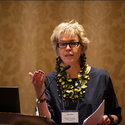Conveying Our Stories - Displaying Our Data (2017)
OSEP supports States and IDEA discretionary grant investments to improve results for children with disabilities and their families. Effectively sharing and communicating the positive outcomes of such efforts to meet the information needs of different audiences is often challenging. OSEP’s third symposium in the 2017 Symposia Series, “Conveying Our Stories--Displaying Our Data,” focused on how States, districts, and Part D-funded investments can develop engaging stories and effectively use data to improve communication strategies used with stakeholders, leadership, and decision makers. The symposium explored best practices and tips for more impactful and effective communication efforts.
Examples included:
- Information on building an effective dissemination plan; and
- Using infographics and data visualization practices to communicate the meaning of data in a way that is accessible, accurate, and actionable for a variety of stakeholders.
Tips covered:
- Using social media to improve outreach, and
- Measuring success using analytic tools.
Archived Meeting Recording & Resources
- Transcript (PDF)
- Symposium Presentation (PowerPoint)
- Q&A (PDF)
-
Symposium Videos
- Planning for Effective Communication and Engagement (Link to YouTube Video)
- Three Lessons to Meaningfully Engage Stakeholders (Link to YouTube Video)
- Social Media: New Low-Cost Tools for Effective Outreach (Link to YouTube Video)
Presenter Information
Evaluations
Symposium Prework
About Pre-Work
The following resources can be used to help States, districts, and Part D-funded investments improve communication with a variety of stakeholders. As part of our effort to create an engaging and meaningful event, we invite you to explore resources that are relevant to your work.
Ask Questions
Email osep-meeting@air.org to ask a question*
This document contains resources that are provided for the user’s convenience. The inclusion of these materials is not intended to reflect its importance, nor is it intended to endorse any views expressed, or products or services offered. These materials may contain the views and recommendations of various subject matter experts as well as hypertext links, contact addresses and websites to information created and maintained by other public and private organizations. The opinions expressed in any of these materials do not necessarily reflect the positions or policies of the U.S. Department of Education. The U.S. Department of Education does not control or guarantee the accuracy, relevance, timeliness, or completeness of any outside information included in these materials.
Resources
State Exemplars
- Vermont’s Family Survey Data Sharing
This PowerPoint presentation highlights how the Vermont Children’s Integrated Services Early Intervention Family Survey is used to connect with families and improve the quality of programs and services in the State.
-
California: Indicator 7 Reports for Local Education Agencies
This video highlights how California is sharing their preschool outcome data in a visually appealing and accessible format. -
Virginia: Strategies for Displaying Data to Support Virginia’s Early Intervention Program
Virginia’s Part C program has created several documents that use infographics or other methods of displaying data to enhance communication and data-based decision making. -
Wisconsin: An Overview of the Serving on Groups Module
This video provides an overview of how Wisconsin is creating more opportunities for parents of students with disabilities to build authentic partnerships with schools. -
Connecticut: Data Visualization and Social Media for Stakeholder Engagement
Connecticut’s early intervention website presents a variety of data about student outcomes and programs serving students. This video discusses how they are presenting this data and using social media to communicate with their stakeholders. -
Florida Positive Behavioral Interventions & Support Project
Florida Positive Behavioral Interventions & Support Project’s 2015-2016 Annual Report -
Wisconsin Rtl Center
Wisconsin RtI Center’s 2015-2016 Annual Report -
Delaware Positive Behavior Support Project
Delaware Positive Behavior Support Project’s 2015-2016 Annual Report
Communication Toolkits and Tips
-
Strategies to Engage Stakeholders with Your Work
This document provides engagement strategies that you may use to reach various audiences. The engagement strategies identified also provide an estimate of effort and cost. -
Effectively Communicating Evaluation Findings
This CIPP TA product is designed to help grantees effectively communicate information about project progress and results to a variety of audiences. The product includes a discussion of why grantees might want to communicate with a specific audience, and outlines key questions to ask when designing a communications plan for different audiences. It highlights some contextual factors that might influence communications with specific audiences, and presents a brief discussion of challenges and ethical considerations associated with communicating evaluation findings. It also provides an overview of common communication tools and products that have been found useful with specific audiences. Throughout, checklists and worksheets tailored to specific audiences are included to help staff think through how to create a plan to link evaluation data and communication strategies.
-
SIGNetwork Marketing Toolkit
This website contains resources that can help organizations improve communication and marketing to deliver their message to specific audiences. The site includes information about developing artwork, newsletters, presentations, and many other communication and marketing tools.
-
SISEP Communication Protocol
This lesson introduces you to a tool for creating a strategic plan for communication in your organization.
-
Communication Module Series
This series of interactive, self-paced learning modules from the National Resource Center for Mental Health Promotion and Youth Violence Prevention can support a strategic approach to communication planning that is designed to enhance program success and sustainability.
-
HHS Office of Adolescent Health Strategic Communications Toolkit
This learning module guides participants through the stages of developing a communication plan, and provides a template for creating a communication plan.
-
How Great Leaders Inspire Action
Simon Sinek makes an argument for communicating the “why” in business vs. the how or what. Why are we collecting this data? Why do we do what we do?
-
Strategic Public Relations Plans are Essential for Business
This short article makes an argument for why all companies should have a public relations plan.
-
Content Marketing for “Boring” Industries: 10 Tips for Creating Interesting Content
This blog post offers tips for communicating “boring” information in an engaging manner.
-
What Work Media Project
Results for America is helping decision-makers at all levels of government accelerate their use of evidence and data.
Data Visualization
DaSy Resources
-
DaSy Center Data Visualization Toolkit
This 2016 toolkit is a compilation of resources for creating engaging data displays, as well as tips for effective use. The toolkit organizes key information and resources for Part C and Part B program use and provides considerations for the type of data and audience that best match each resource. The toolkit content provides the depth and specificity needed to learn new skills and apply them directly to your work.
-
Using the DaSy-NCSI Data Visualization Toolkit to Create Engaging and Effective Data Displays
This session introduces the new DaSy-NCSI Data Visualization Toolkit. The toolkit identifies key design principles, data considerations, and accessibility concerns that need to be addressed to effectively present data, and identifies low cost/no cost data visualization tools.
- Chart with Purpose
In this first of three 30-minute data visualization talks, presenters defined data visualization and addressed five common pitfalls when creating charts: (1) Not clearly articulating your message; (2) Beginning with the visualization technique vs. the data; (3) Misrepresenting your data; (4) Being dull; and (5) Forgetting about accessibility.
- Powerful Presentations
The second of three 30 minute data visualization talks, this webinar focuses on effectively presenting data using animation and presentation tools. Presenters will walk the audience through the process of taking complex concepts and data and creating a fun, engaging animation and presentation.
- Infographics for Impact
The final of three 30 minute data visualization talks, this webinar focuses on how to effectively create and use infographics and answers 3 key questions: 1.) How can infographics be useful? 2.) What are some examples? 3.) What are tips for getting started?
- Improving Programs through Data-Driven Decisions: The Journey from Critical Questions to Data Visualization
This session provides states with a roadmap for identifying, organizing, and visually displaying the data elements needed to answer state prioritized questions. This process is demonstrated using the Center for Early Childhood IDEA Data Systems (DaSy) Critical Questions and the Common Education Data System (CEDS) Connect Tool. Through collaborative efforts, DaSy and CEDS are developing templates to identify the data elements needed to address critical question, provide suggested analyses, and give examples of tables or graphs for displaying the data.
IDC Resources
-
Now You See It: Seeing the Story in the Data
The session from the 2015 OSEP Leadership Conference demonstrated creative ways data are being displayed to tell the story of IDEA and other data.
-
Show Me the Data – Data Visualization and Presentation Webinar Series (Parts 1 and 2)
These webinars present an introduction to data visualization.
- Assessment Interactive Map
States and territories can use this interactive map, which features data from every state and territory, to identify other states and territories with similar concerns or similar contexts, with a view to beginning a dialogue around improving outcomes for children and students with disabilities.
Data Quality Campaign (DQC) Resources
DQC is dedicated to building knowledge and developing resources that advance the effective use of education data. DQC’s website contains a variety of resources including the following:
- Time to Act 2017: Put Data in the Hands of People
More must be done to put data in the hands of people. States have made significant investments in data infrastructure, but data will never be used as a tool to inform continuous improvement and support student success unless parents, educators, policymakers, and students themselves have access to timely, useful information
- Opportunities to Make Data Work for Students in the Every Student Succeeds Act
This document provides examples and suggestions for how States can use data to meet and go beyond ESSA requirements and support students and schools
-
What Every Parent Should Be Asking about Education Data and Privacy
This two-page resource offers parents critical questions they should be asking about the value of education data and how student privacy is ensured.
Other Resources
-
Forum Guide to Data Visualization: A Resource for Education Agencies
The purpose of this document is to recommend data visualization practices that will help education agencies communicate data meaning in visual formats that are accessible, accurate, and actionable for a wide range of education stakeholders.
-
Graphic Design for Researchers
This guide offers a basic overview on how researchers can effectively use design to create engaging and visually appealing Regional Educational Laboratory (REL) products. It will cover some key concepts behind good design and discuss how to use basic elements like photographs, images, color, tables, figures, and type to create useful publications and digital products. The guide also touches on how researchers can use data visualization to make complex concepts accessible. -
Easel.ly’s Crash Course in Infographics
This crash course on infographics is itself presented as an infographic. -
Center for Parent Information and Resources Webinar on Creating Infographics
The webinar introduces infographics, why they are popular, and resources for creating your own infographics.
Family Engagement
-
REL Pacific Toolkit of Resources for Engaging Parents and Community as Partners in Education
The Toolkit of Resources for Engaging Parents and Community as Partners in Education is designed to guide school staff in strengthening partnerships with families and community members to support student learning. Part 4 of the Toolkit focuses on engaging in data conversations with families and community members.
-
American Evaluation Association Blog: Involving Families in the Data
This blog post provides tips for engaging families in data collection, reflection, and use.
-
How to Share Data Effectively: Tips for Administrators, Teachers, and Families This resource from the former Harvard Family Research Project contains valuable tips for sharing data with Families.
-
Data Driven: Making Student and School Data Accessible and Meaningful to Families
This webinar—Data Driven: Making Student and School Data Accessible and Meaningful to Families— takes a look at practical examples of how districts and schools are using data to engage families in their children's education. The webinar introduces tools that enable practitioners, districts, and schools to incorporate data into their own family engagement strategies.
-
Improving Family and Community Engagement Through Sharing Data
This 2012 briefing paper from the Southeast Comprehensive Center reviews the literature on how education agencies can use data to drive continuous improvement and engage parents and other stakeholders.
-
Data Resources for Families
This webpage provides links to a variety of data resources for families.
-
Demystifying the “D” Word: Making Data Meaningful for Families
This presentation demonstrates the key uses for data in Early Intervention/Early Childhood Special Education and shares strategies for helping families feel more comfortable having data conversations. This is important because, in order to effectively partner with practitioners, families need to understand what data are collected and how those data are used to inform decisions.
-
How Data Empowers Parents
This infographic highlights the ways in which a data dashboard can help parents better understand their child’s academic progress and access additional resources.
-
Using Data for Collaboration and Advocacy
A webinar from the Center for Parent Information and Resources highlights how data can be used for collaboration and resources, as well as the data available from the Office of Civil Rights in the US Department of Education. The landing page includes additional resources.
Social Media Resources
-
Social Media Audits
This short article explains how to assess your social media efforts and determine what you're doing right and what you could do better.
-
Social Media ROI: 14 Formulas to Measure Social Media Benefits
For those looking for a way to justify the costs and efforts associated with social media, here is a quick overview of Return on Investment and Cost Benefit Analysis and how to apply them to social media
-
9 Social Marketing Metrics That Actually Matter
This post addresses items that are harder to capture in return on investment numbers. It looks at added value through stakeholder engagement and people taking action on your posts, not just viewing the posts. - This webpage from the U.S. Department of Education includes links to several resources designed to support SEAs use of social media to engage stakeholders.
-
Social Media Tip Sheets:
The Reform Support Network created social media tip sheets to help State and local education agencies expand their efforts to communicate and engage with key audiences on reform topics via social media.
-
Using Social Media to More Effectively Communicate Reform Efforts: A Case Study on the Ohio Department of Education’s Use of Twitter
Ohio is one of the leading State education agencies embracing and experimenting with social media. This publication details how the Ohio Department of Education used social media, including Twitter and a WordPress blog, to drive interest and engagement in its 2012 statewide educator conference, Connecting the Dots, and how this strategy resulted in creating a network of educators statewide.
-
Measurable Success, Growing Adoption, Vast Potential: Social Media Use Among State and Local Education Agencies
This report presents data collected through a questionnaire of State education agencies and local educational agencies on the growing use of social media to reach key stakeholder groups and engage with primary audiences.
-
Building Enduring Race to the Top Education Reforms: Using Social Media to Engage With and Communicate to Key Stakeholders
This guide describes emerging social media practices among State education agencies and other governmental organizations and suggests key steps and considerations for those interested in using social media to advance education reform.
-
Social Media: New Low-cost Tools for Effective Outreach
This session from the 2017 OSEP Leadership Conference focuses on how to engage diverse communities using new, low-cost tools through social media networking.
-
Social Amplification
This article explains what social amplification is and how organizations can use it to create greater engagement and influence around a topic.
Examples of Effective Communication
-
Teaching Exceptionally Podcasts
CEC produces two podcasts that aim to support special education teachers by providing resources and evidenced-based information in an engaging format.
-
Reality 101 Blog
This blog is for new special education teachers to share their stories and connect with other special educators.
-
CEC’s Tool of the Week
This resource is aimed at enhancing the work of special education teachers by providing free tools that can be used in the classroom to support student learning.
-
NCII’s Ask the Expert Videos
Ask the Expert videos are short video clips of experts in the field addressing frequently asked questions about intensive, individualized interventions in academics and behavior.
-
Examples of infographics from REL Midwest
RELs develop a wide variety of infographics to display information from their work in graphical form.
-
Vermont’s Early Childhood Data Reporting System (ECDRS)
This website is an integrated online toolbox that equips Vermonters to leverage meaningful data for the well-being of children, families and communities.
-
School Improvement Explained: How GIS Mapping Can Help Improve Schools
Location can play an important role in school improvement efforts. In this video, Trent Sharp, AIR senior technical assistance consultant, talks about how geographic information systems (GIS) data can be used with school and other demographic and social information to better inform school improvement efforts.
-
NCSI State Snapshots and State Spotlights
These resources from NCSI highlight the technical assistance work that the center is engaged in and provide information in an accessible format.
-
National Center for Learning Disabilities
The NCLD website contains a variety of engaging resources including a blog that highlights recent work and new resources.
Symposium Postwork
Thank you for your interest in the OSEP Symposia Series post-work. This event is now archived and the discussion board closed. If you were unable to attend the live events, you may view an archived version of the Symposium on Significant Disproportionality presentation and the Creating Safe, Supportive Learning Environments for Children with Disabilities presentation.
Special Needs
Mobile Website
Lodging, Dining, Activities
Call for Proposals
Speaker Bios

Ruth Ryder is the acting director of the Office of Special Education Programs (OSEP) in the Office of Special Education and Rehabilitative Services (OSERS) at the U.S. Department of Education. OSERS provides leadership to achieve full integration and participation in society of people with disabilities by ensuring equal opportunity and access to, and excellence in, education, employment, and community living. OSEP assumes a national leadership role by supporting its customers and partners through technical assistance, personnel preparation, parent training, technology, data collection, data reporting and use, and monitoring and support.
Ms. Ryder has been in a variety of positions in OSEP since 1988, currently as the OSEP acting director. In this position, she provides national leadership for moving special education accountability to a more results-oriented focus. In addition, Ms. Ryder focuses attention on ensuring that the needs of children with disabilities are addressed in the major initiatives of the Department, such as the Every Student Succeeds Act, family engagement, school climate transformation, and early learning.
Prior to joining OSEP, Ms. Ryder was a program administrator in a Washington State school district. There she had responsibility for an OSERS-funded special education demonstration project, examining integrated service delivery models for including children with disabilities in general education. She also administered the Elementary and Secondary Education Act Title I and Title II programs, State-remediation, gifted education, outcome-based education, and State- and district-wide testing programs. Additionally, Ms. Ryder has been a special education consulting teacher and a general education classroom teacher. Ms. Ryder has a bachelor’s degree in psychology and elementary education and a master’s degree in special education.

Jane West, Ph.D. is a visiting professor at the University of Maryland and policy advisor to several national education organizations, including the American Association of Colleges for Teacher Education (http://aacte.org/), the National Network of State Teacher of the Year (http://www.nnstoy.org/), the Higher Education Consortium for Special Education (http://www.hecse.net/) and the Teacher Education Division of the Council for Exceptional Children (http://www.tedcec.org/). For eight years, she led AACTE’s advocacy and policy work as senior vice president. In the mid-1980s she worked as senior education advisor on the United States Senate Committee on Health, Education, Labor and Pensions where she led the national effort to craft multiple federal education statutes. In addition, Dr. West is a former teacher and education administrator.
Focusing on bringing the voice of expert education practitioners into the national policy dialogue, Dr. West supports professionals – teacher educators, expert teachers, researchers, principals, doctoral students and others – in engaging in the policy making process by honing their message, supporting it with evidence, engaging at the right time during the process and building effective political alliances.

Clement Coulston is a national presenter, curriculum developer and content organizer, and serves as the manager of communications and public relations at the National Association of School Psychologists. Mr. Coulston has consulted for the National Association of State Directors of Special Education to further its Leading by Convening work through utilizing infographics and social media. He offers workshops at the state, national, and international levels and specializes in stakeholder engagement, transition, advocacy, and inclusion. You can follow him on social media: @clementc26.

Todd Grindal, Ed.D. is a senior researcher and co-director of the early learning group at SRI. Dr. Grindal works with the Center for IDEA Early Childhood Data Systems where he is leading a quasi-experimental study examining the associations between participation in early intervention services and kindergarten outcomes. Prior to joining SRI, Dr. Grindal led a range of evaluation and technical assistance projects. He led multi-year studies of the identification, placement, and performance of special education students in Massachusetts, Texas, and Ohio. These mixed method studies focused on how student, school, and community characteristics are associated with students’ participation in different types of educational programs such as charter schools, private schools, and inclusive public schools. In other recent work, Dr. Grindal directed a comprehensive review of the evidence on inclusive education and presented findings from this work at the United Nations. Dr. Grindal conducted his masters and doctoral work at the Harvard Graduate School of Education where he was awarded a Julius B. Richmond Fellowship by the Harvard Center on the Developing Child. Prior to beginning his doctoral studies, he worked for six years as a teacher and school administrator.

Kevin Hager is vice president and chief digital officer for the National Center for Learning Disabilities (NCLD) and serves as managing director for Understood. He leads strategy and operations across the Understood ecosystem to support parents of the one in five kids with learning and attention issues. Under Mr. Hager’s leadership, Understood has grown since its launch in October 2014 into an active online resource and community, reaching nearly 2 million visitors per month through personalized resources, tools, and expert access. His passion for learning and attention issue advocacy comes from his personal experience living with attention-deficit hyperactivity disorder (ADHD). Prior to Understood and NCLD, Mr. Hager served as development director at DoSomething.org and managed the creation of the Center for Service Learning at the University of Kansas. He also worked in politics in press and campaign management roles.
Mr. Hager serves on the national advisory board for SXSWEdu, is secretary of the board of directors for the Dramatists Guild Fund and regularly speaks at conferences, including the World Economic Forum, on development strategies.

Kristen Kushiyama, MBA, has served as a public affairs specialist with the Department of Education’s Office of Special Education and Rehabilitative Services (OSERS) since January 2017. Her primary role to date has been to coordinate the redevelopment of the Department’s Individuals with Disabilities Education Act (IDEA) website. Prior to coming to the Department of Education, Kristen served as a public affairs specialist for one of the U.S. Army’s research, development and engineering centers. Kristen holds degrees in both communication with a public relations emphasis and dance from the University of Maryland, College Park and an MBA from Rutgers – the State University of New Jersey.

Jill Lammert, Ph.D. is a research methodologist and Westat senior study director with 18 years of experience designing, conducting, and analyzing research to support education policy and practice. She has participated in the design and implementation of federal, State, and local evaluations of education programs and provided technical assistance (TA) in research and evaluation methodology to the Office of Special Education Programs (OSEP) grantees, project evaluators, and OSEP staff, as well as grantees of the Department’s Investing in Innovation (i3) program. Dr. Lammert is currently co-director of the Center to Improve Program and Project Performance (CIPP), which is in its third iteration. In addition to her management responsibilities and her direct TA work, she has authored or contributed to the development of all of CIPP’s TA products, including, among others, Demonstrating Evidence Across the Project Cycle; Evaluating Special Education Programs: Resource Toolkit; Budgeting for Evaluation: Key Factors to Consider; Guidelines for Working with Third-Party Evaluators; Project Evaluation Assessment Tool; and Evaluating Special Education Preservice Programs Using Graduate and Student Outcomes: Resource Toolkit. Additionally, she is leading development of the IDEA Data Center’s tools and products related to significant disproportionality. Dr. Lammert has also developed and delivered trainings and webinars, including a training workshop for OSEP on measuring the fidelity of implementation for staff and grantees. Her interests include measurement of implementation fidelity and advanced qualitative and quantitative research methods. She is a What Works Clearinghouse-certified reviewer for group and single-case designs.